Page 3 of 4
Posted: Tue Mar 11, 2008 3:46 pm
by iknowmy3tables
no thats exactly what I meant, I said that the pressure on both sides would be the same didn't I, what I am saying is that the force on both sides wont be even (although the pressure is the same) because the difference in surface area, see the diagram see how the red is larger than the blue, so the bolt wont stay back when the pressure is full it will push the bolt forward even when the area in front of the o-rings is not vented (again because the area is not large enough)
Posted: Tue Mar 11, 2008 3:52 pm
by Counterstriker
Sorry for what I am about to say.. But.. Is that just MS paint you made that diagram with?
Posted: Tue Mar 11, 2008 9:28 pm
by iknowmy3tables
Me... I used powerpoint then paint because fixed lengths make it easier to make the drawings symmetrical and proportional as well as add and remove shapes and when I need to go more persice then the fixed lengths I build it big, group them, then shrink them, I copy my product to MS paint and save as a jpeg,
him I think he used MS paint,
Posted: Tue Mar 11, 2008 10:57 pm
by Flash
Me? Are you serious?

I could never have drawn that in paint.
But if what you are saying is the case, then why don't all pistons move back? And there would be less force acting on the back of the bolt than the front because the air would only act on the o-ring at the front, while at the back, air can act on o-ring and the back of the bolt. I forgot to make the bolt stop smaller than the bolt, so in my diagram, there would be more pressure acting on the front.
Here's the bb gun that I was talking about.
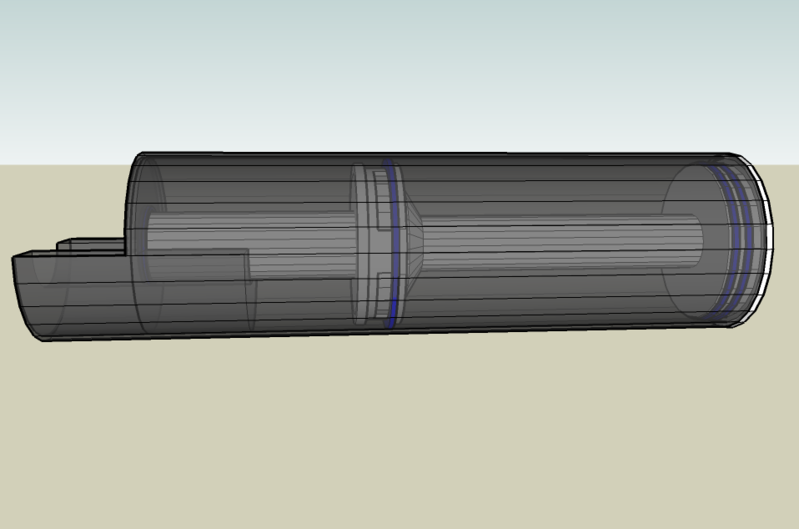
Posted: Wed Mar 12, 2008 9:49 am
by iknowmy3tables
oh of course not the 3d thing, but the other diagrams were in ms paint right
no because normal pistons valves have more more or equal surface area,
if you had a 2 input air cylinder and added equal presure to both sided it would extend because of the unequal suface area.
Posted: Wed Mar 12, 2008 2:50 pm
by Counterstriker
I was talking about the first post, That is google sketchup..

Posted: Wed Mar 12, 2008 8:32 pm
by Flash
Sorry, disregard my previous post. I completely contradict myself within the first and second paragraphs.
Here's a better view of the bolt's surface area.

I am pretty sure that the force of liquids and solids increases as you decrease surface area. That's why barrel sealing piston have such little surface area on its sealing side; to maximize the surface area difference and thusly the force produced. As you can see, the bolt does have less surface area on the back (air chamber) side. If I were to be filling both the pilot side and the air chamber side simulatneously, I might possibly encounter the problem that you stated. But I am only filling the pressure chamber from the pilot side (see al-xg's most recent dedsign). That means the bolt would be filled with air, the bolt would back and air would pressurize on both sides,. The bolt functions exactly like any other piston.
And yes I drew my original designs with MS paint.
Posted: Thu Mar 13, 2008 8:19 pm
by iknowmy3tables
I am pretty sure that the force of liquids and solids increases as you decrease surface area.
no I think your confusing the logic of pumps and how you can produce more pressure with less force using a pump with smaller surface area,
Regardless you couldn't be more wrong, just stop and think about psi, what does it stand for Pounds per a Square Inch, to find the force of a piston you multiply the surface area in square inches with the amount of air pressure
barrel sealing pistons open faster because they delay a little before they open, the pilot pressure is much lower when the valve opens compared to that of a chamber sealing valve, so it kinda "pops" open
Hey someone back me up on this
Posted: Fri Mar 14, 2008 6:58 pm
by Flash
iknowmy3tables wrote:
no I think your confusing the logic of pumps and how you can produce more pressure with less force using a pump with smaller surface area,
Regardless you couldn't be more wrong, just stop and think about psi, what does it stand for Pounds per a Square Inch, to find the force of a piston you multiply the surface area in square inches with the amount of air pressure
barrel sealing pistons open faster because they delay a little before they open, the pilot pressure is much lower when the valve opens compared to that of a chamber sealing valve, so it kinda "pops" open
Pumps are able to create more pressure because they have less surface area. You said it yourself, psi stands for pounds per square inch; or in other words, force divided by surface area in square inches. The formula for calculating pascals is newtons divided by meters squared. Therefore the larger the surface are (square inches or meters squared) the smaller the force, if pressure remains constant.
Here's an example:
Lets calculate the force acting on different sides of a piston. On the pilot side there is 2 square inches. On the sealing side there is 1 square inch. If the force acting on both sides is 10 pounds, then the pilot side would have a pressure of a 5 psi and the sealing side would have 10 psi.
As for the pistons, just watch the shock wave animations in the Types of Pistons sticky. In the upper right hand corner, you can see the pressure difference in th opposing sides of the piston.
Posted: Tue Mar 18, 2008 4:16 pm
by iknowmy3tables
PLEASE SOMEONE HELP ME EXPLAIN THE PHYSICS OF AIR PRESSURE
no you got it wrong in your valves; force is created from the air pressure not the other way around, how the hell do you have diffrent amounts of air pressure on each side of the valve, areas with greater pressure travel to areas with less pressure in during the charged phase the air pressure is equal throughout the valve and chamber
lets calculate the force on a piston correctly
first off your calculating force not pressure, and force is not the same on both sides, so then what is the force on the sides, well thats what were calculating
first you add air pressure so lets say you pump it to 10psi, on the sealing side (1 in^2) will have 10 pounds of force, and on the pilot side (1 in^2) you will have 20 pound of force, because you have 10 pounds of force for every square inch
if your referring to a a barrel sealing piston of course the force is uneven or else the sealing face will not work
Posted: Wed Mar 19, 2008 12:22 am
by Flash
iknowmy3tables wrote:lets calculate the force on a piston correctly
first off your calculating force not pressure, and force is not the same on both sides, so then what is the force on the sides, well thats what were calculating
first you add air pressure so lets say you pump it to 10psi, on the sealing side (1 in^2) will have 10 pounds of force, and on the pilot side (1 in^2) you will have 20 pound of force, because you have 10 pounds of force for every square inch.
Just for clarification, you mean 2 square inches right?
WOW! I feel like an idiot! I always thought that pistons worked because the sealing side had more force than the piston side when the chamber was filled. If I had only looked at the formula of pressure (the one that I quoted like
50 billion times in my last post) I would have realized that force increases with surface area.
iknowmy3tables, you called it earlier. I completely misunderstood how hydraulics work and it transfered over to my view of piston physics. I don't think there are enough "oops" smilies to show how stupid I feel.
So barrel sealing pistons work because the pilot force has to drop significantly before the piston can move back. When it finally does, air is exposed to to the whole sealing face and it causes an extreme change in forces resulting in the fast opening time associated with barrel sealing pistons.
I need to redesign the bolt now, but here is what I made before I realized how much of a tard I am. Its only the bolt, valve, QEV, and regulator.

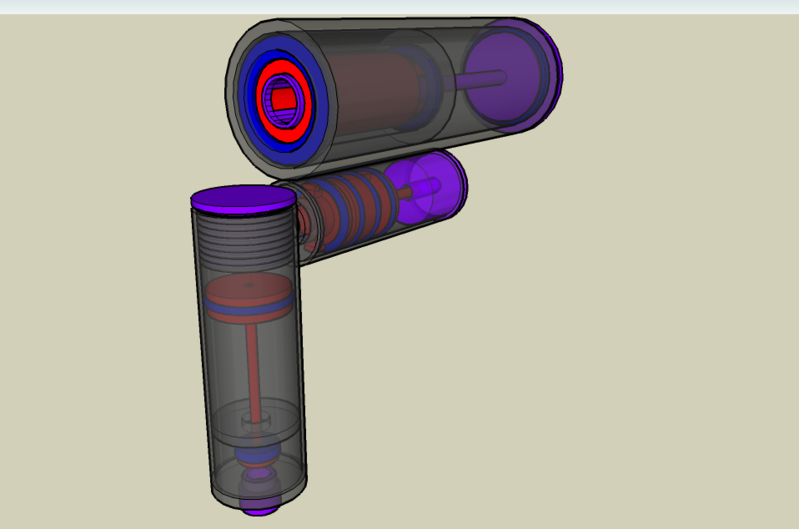
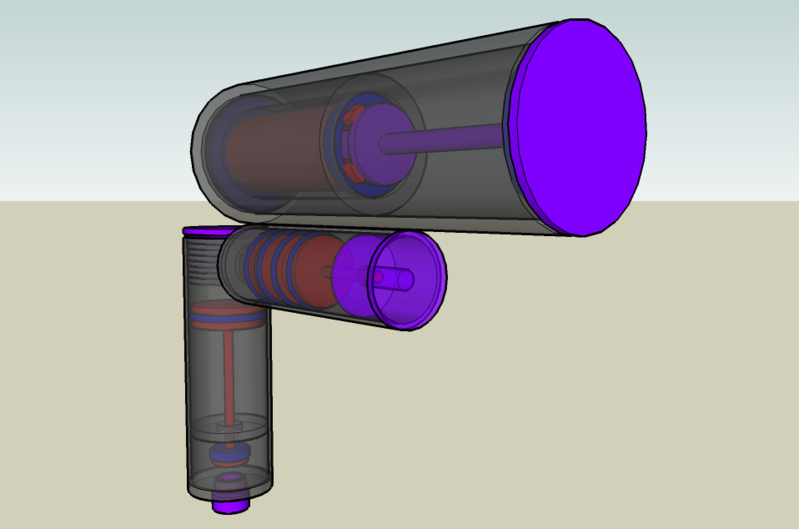
Posted: Wed Mar 19, 2008 12:35 am
by Novacastrian
iknowmy3tables wrote:
if your referring to a a barrel sealing piston of course the force is uneven or else the sealing face will not work
No the pressure is even inside the chamber, the reason it works is that the air is trying to escape but is getting blocked by the piston, it becomes uneven when piloted, hence the piston moves backwards.
Posted: Wed Mar 19, 2008 10:48 am
by Flash
Novacastrian wrote:
No the pressure is even inside the chamber, the reason it works is that the air is trying to escape but is getting blocked by the piston, it becomes uneven when piloted, hence the piston moves backwards.
Oh yeah, we know that. He was just trying to explain to me the force differences involved with pistons, not the air flow.
Here's a close up of the bolt and 3 way valve.
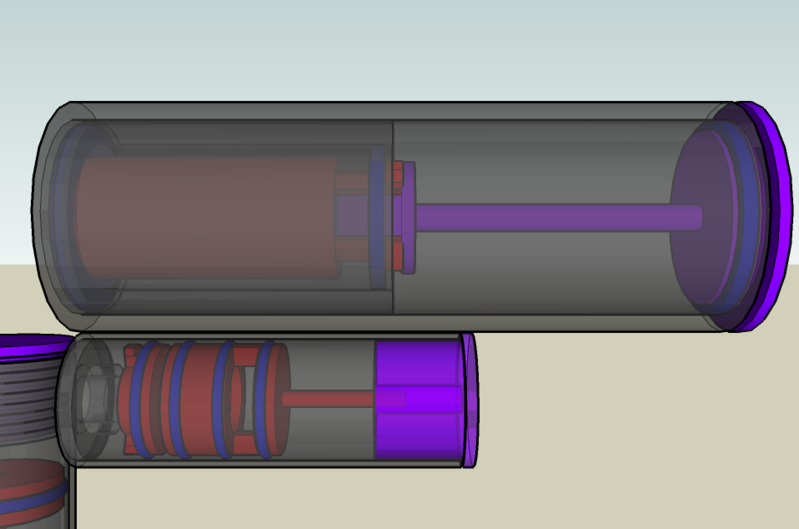
I realized that the floating o-ring does much more than act as a check valve. When the firing chamber is filling, the o-ring slides back. This exposes the o-ring's entire left side. On the firing chamber side, there bolt rod exposes a little more than half of the o-ring. It's a marginal difference, but it still does result in a force difference, something that most high end electro-pneumatic markers lack.
The 3 way valve is designed so it can be activated by a solenoid. This solves the problem I had with finding a way to pull the trigger from that position. It also means that the valve will open much faster and thusly a higher ROF.
Posted: Thu Mar 20, 2008 9:43 pm
by iknowmy3tables
Just for clarification, you mean 2 square inches right?
yes, its alright man, barrel sealers are pretty weird, it took me a long time to grasp the fact that they open faster than chamber sealers
anyways I thought of several possible ways to fix the surface area problem:
add spring tension to help assist pilot presure
actuate the relese mechanically rather than pneumatically
abandon the telescoping design for something based on the origenal blow forward bolt
(if originality of design hold a lot of importance to you then you should check out some of the
other designs )
Posted: Fri Mar 21, 2008 11:03 am
by Flash
Wait, is there still a surface area problem with the o-ring? I mean when its filling, the entire left side is exposed compared to the right side where only half of the o-ring and a little bit more is exposed because the bolt rod is covering the rest. So it should stay back when it is being filled right? And when the pilot is activated, the o-ring moves back and now the entire right side is exposed and the wall of the bolt's walls. And would that give it more surface area?
I'll post a quick diagram later if I'm not explaining myself clearly.
Chamber filling


Pilot Opened
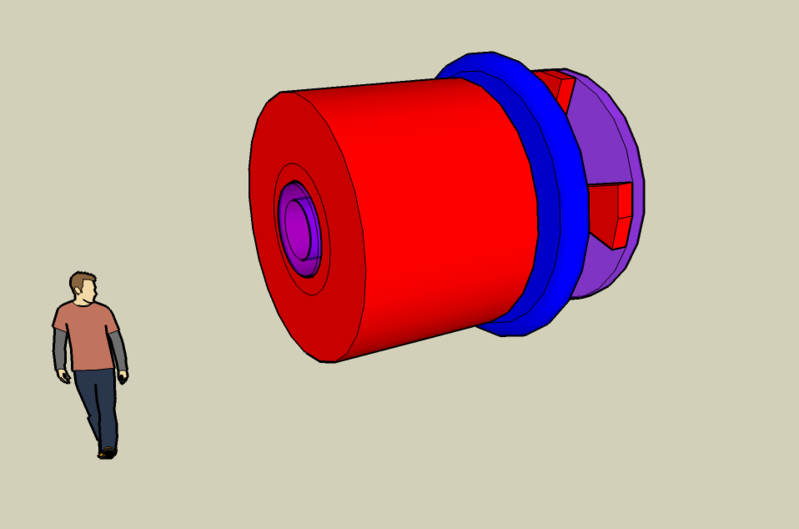

EDIT: Damn it! I forgot to delete the SketchUp character. Now all my pictures have some weird guy in the background.









